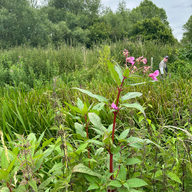HIMALAYAN BALSAM REMOVAL
Our rivers serve as vital wildlife corridors for a diverse array of animals, birds, and plants. They offer free movement between habitats, safe refuge, abundant food supplies, and support the completion of many species' lifecycles. However, invasive non-native species (INNS) frequently become part of our river ecosystems. These plants and animals can outcompete native species, spread disease, cause habitat loss, damage riverbanks, and prey on native wildlife.
Himalayan balsam (Impatiens glandulifera) has quickly become one of the UK's most invasive weed species, spreading across riverbanks, waste ground, and damp woodlands. It outcompetes native plants for space, light, nutrients, and pollinators, often displacing other species and reducing native biodiversity.
The Essex and Suffolk Rivers Trust conducts seasonal Himalayan balsam clearance in two catchment areas. The first area includes the River Stour and its tributaries, the Rivers Box and Brett, along with the Brett's tributaries, Lavenham Brook and Bildeston Brook. The second area focuses on the River Fynn, located north of Ipswich.
%20copy.jpg)
What is Himalayan Balsam?
As its name suggests, Himalayan balsam originates from the Himalayas north of Pakistan and India and was originally introduced to the UK in 1839 as an ornamental garden plant. However, it quickly spread beyond gardens and became an invasive weed along riverbanks and ditches, especially close to towns.
Himalayan balsam is fast-growing and spreads quickly, invading wet habitat at the expense of other, native flowers. A distinctive plant with reddish jointed stems and long, green, oval-shaped leaves, the flowers range from fuchsia to pale pink in colour and tend to appear between June and October. Its explosive seed pods aid its spread by sending the seeds into the river, causing further dispersal downstream.

Download the full ID Sheet or visit www.nonnativespecies.org for more information.
River Stour and Tributaries Project
We have partnered with Essex and Suffolk Water on a three-year Himalayan Balsam removal project focusing on the Rivers Stour, Box, Brett and its tributaries. This project has run from 2022-2024 and the ESRT are hopeful that a new round of work can be funded and scheduled for 2025 and beyond.
In 2024 our team and volunteers cleared 3.2km of the River Brett, 1.4km of the River Box and 1.2km of the River Stour. In the future this can be extended with additional partnership working and volunteer hours.
This project is funded by the Essex and Suffolk Water Branch Out Invasive Non-Native Species (INNS) fund. In 2025 we secured additional funding from the Dedham Vale National Landscape & Stour Valley Sustainable Development Fund.


River Fynn Project
We began our work on the river Fynn in 2024. The initial year of work has been very productive, with 6km of Himalayan balsam cleared from Tuddenham St. Martin to beyond Little Bealings, just upstream of the confluence with the River Lark. We are hopeful that this has been an effective measure on this river and aim to return in 2025 to cover a larger area and observe the effectiveness of our work.
This project is funded by the Anglian Water Invasive Species Fund and the grant is administered by the Cambridgeshire Community Foundation.


Further Work
We are always looking to expand our coverage of balsam clearance. In 2025 we hope to expand into new river catchments, offer additional volunteering opportunities and experiment with new techniques. If you are a riparian landowner in Essex or Suffolk and have Himalayan balsam on your watercourse then contact our team to see if we can include you in our future work.




















